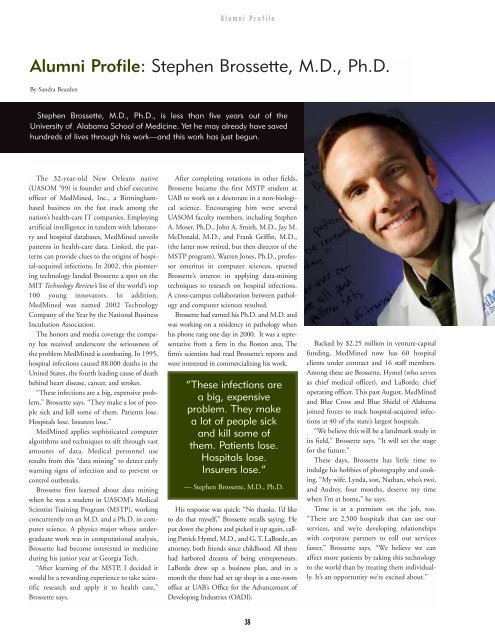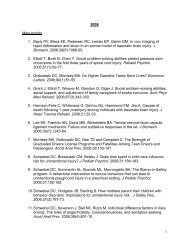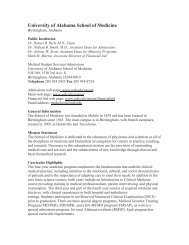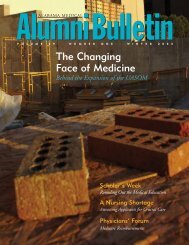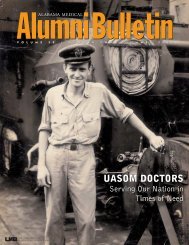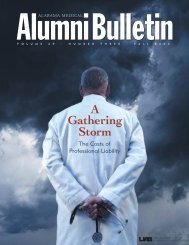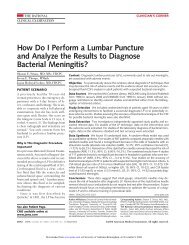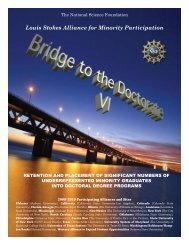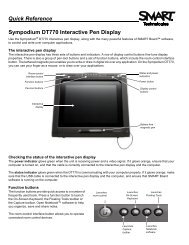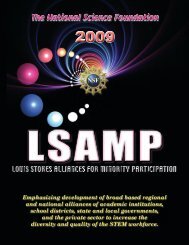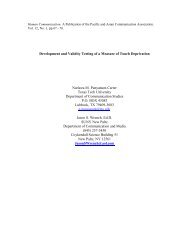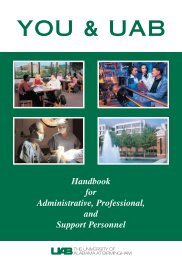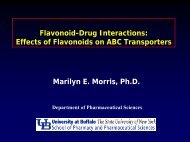the pursuit of parkinson's - The University of Alabama at Birmingham
the pursuit of parkinson's - The University of Alabama at Birmingham
the pursuit of parkinson's - The University of Alabama at Birmingham
You also want an ePaper? Increase the reach of your titles
YUMPU automatically turns print PDFs into web optimized ePapers that Google loves.
Alumni Pr<strong>of</strong>ile<br />
Alumni Pr<strong>of</strong>ile: Stephen Brossette, M.D., Ph.D.<br />
By Sandra Bearden<br />
Stephen Brossette, M.D., Ph.D., is less than five years out <strong>of</strong> <strong>the</strong><br />
<strong>University</strong> <strong>of</strong> <strong>Alabama</strong> School <strong>of</strong> Medicine. Yet he may already have saved<br />
hundreds <strong>of</strong> lives through his work—and this work has just begun.<br />
<strong>The</strong> 32-year-old New Orleans n<strong>at</strong>ive<br />
(UASOM ’99) is founder and chief executive<br />
<strong>of</strong>ficer <strong>of</strong> MedMined, Inc., a <strong>Birmingham</strong>based<br />
business on <strong>the</strong> fast track among <strong>the</strong><br />
n<strong>at</strong>ion’s health-care IT companies. Employing<br />
artificial intelligence in tandem with labor<strong>at</strong>ory<br />
and hospital d<strong>at</strong>abases, MedMined unveils<br />
p<strong>at</strong>terns in health-care d<strong>at</strong>a. Linked, <strong>the</strong> p<strong>at</strong>terns<br />
can provide clues to <strong>the</strong> origins <strong>of</strong> hospital-acquired<br />
infections. In 2002, this pioneering<br />
technology landed Brossette a spot on <strong>the</strong><br />
MIT Technology Review’s list <strong>of</strong> <strong>the</strong> world’s top<br />
100 young innov<strong>at</strong>ors. In addition,<br />
MedMined was named 2002 Technology<br />
Company <strong>of</strong> <strong>the</strong> Year by <strong>the</strong> N<strong>at</strong>ional Business<br />
Incub<strong>at</strong>ion Associ<strong>at</strong>ion.<br />
<strong>The</strong> honors and media coverage <strong>the</strong> company<br />
has received underscore <strong>the</strong> seriousness <strong>of</strong><br />
<strong>the</strong> problem MedMined is comb<strong>at</strong>ing. In 1995,<br />
hospital infections caused 88,000 de<strong>at</strong>hs in <strong>the</strong><br />
United St<strong>at</strong>es, <strong>the</strong> fourth leading cause <strong>of</strong> de<strong>at</strong>h<br />
behind heart disease, cancer, and strokes.<br />
“<strong>The</strong>se infections are a big, expensive problem,”<br />
Brossette says. “<strong>The</strong>y make a lot <strong>of</strong> people<br />
sick and kill some <strong>of</strong> <strong>the</strong>m. P<strong>at</strong>ients lose.<br />
Hospitals lose. Insurers lose.”<br />
MedMined applies sophistic<strong>at</strong>ed computer<br />
algorithms and techniques to sift through vast<br />
amounts <strong>of</strong> d<strong>at</strong>a. Medical personnel use<br />
results from this “d<strong>at</strong>a mining” to detect early<br />
warning signs <strong>of</strong> infection and to prevent or<br />
control outbreaks.<br />
Brossette first learned about d<strong>at</strong>a mining<br />
when he was a student in UASOM’s Medical<br />
Scientist Training Program (MSTP), working<br />
concurrently on an M.D. and a Ph.D. in computer<br />
science. A physics major whose undergradu<strong>at</strong>e<br />
work was in comput<strong>at</strong>ional analysis,<br />
Brossette had become interested in medicine<br />
during his junior year <strong>at</strong> Georgia Tech.<br />
“After learning <strong>of</strong> <strong>the</strong> MSTP, I decided it<br />
would be a rewarding experience to take scientific<br />
research and apply it to health care,”<br />
Brossette says.<br />
After completing rot<strong>at</strong>ions in o<strong>the</strong>r fields,<br />
Brossette became <strong>the</strong> first MSTP student <strong>at</strong><br />
UAB to work on a doctor<strong>at</strong>e in a non-biological<br />
science. Encouraging him were several<br />
UASOM faculty members, including Stephen<br />
A. Moser, Ph.D., John A. Smith, M.D., Jay M.<br />
McDonald, M.D., and Frank Griffin, M.D.,<br />
(<strong>the</strong> l<strong>at</strong>ter now retired, but <strong>the</strong>n director <strong>of</strong> <strong>the</strong><br />
MSTP program). Warren Jones, Ph.D., pr<strong>of</strong>essor<br />
emeritus in computer sciences, spurred<br />
Brossette’s interest in applying d<strong>at</strong>a-mining<br />
techniques to research on hospital infections.<br />
A cross-campus collabor<strong>at</strong>ion between p<strong>at</strong>hology<br />
and computer sciences resulted.<br />
Brossette had earned his Ph.D. and M.D. and<br />
was working on a residency in p<strong>at</strong>hology when<br />
his phone rang one day in 2000. It was a represent<strong>at</strong>ive<br />
from a firm in <strong>the</strong> Boston area. <strong>The</strong><br />
firm’s scientists had read Brossette’s reports and<br />
were interested in commercializing his work.<br />
“<strong>The</strong>se infections are<br />
a big, expensive<br />
problem. <strong>The</strong>y make<br />
a lot <strong>of</strong> people sick<br />
and kill some <strong>of</strong><br />
<strong>the</strong>m. P<strong>at</strong>ients lose.<br />
Hospitals lose.<br />
Insurers lose.”<br />
— Stephen Brossette, M.D., Ph.D.<br />
His response was quick: “No thanks. I’d like<br />
to do th<strong>at</strong> myself,” Brossette recalls saying. He<br />
put down <strong>the</strong> phone and picked it up again, calling<br />
P<strong>at</strong>rick Hymel, M.D., and G. T. LaBorde, an<br />
<strong>at</strong>torney, both friends since childhood. All three<br />
had harbored dreams <strong>of</strong> being entrepreneurs.<br />
LaBorde drew up a business plan, and in a<br />
month <strong>the</strong> three had set up shop in a one-room<br />
<strong>of</strong>fice <strong>at</strong> UAB’s Office for <strong>the</strong> Advancement <strong>of</strong><br />
Developing Industries (OADI).<br />
Backed by $2.25 million in venture-capital<br />
funding, MedMined now has 60 hospital<br />
clients under contract and 16 staff members.<br />
Among <strong>the</strong>se are Brossette, Hymel (who serves<br />
as chief medical <strong>of</strong>ficer), and LaBorde, chief<br />
oper<strong>at</strong>ing <strong>of</strong>ficer. This past August, MedMined<br />
and Blue Cross and Blue Shield <strong>of</strong> <strong>Alabama</strong><br />
joined forces to track hospital-acquired infections<br />
<strong>at</strong> 40 <strong>of</strong> <strong>the</strong> st<strong>at</strong>e’s largest hospitals.<br />
“We believe this will be a landmark study in<br />
its field,” Brossette says. “It will set <strong>the</strong> stage<br />
for <strong>the</strong> future.”<br />
<strong>The</strong>se days, Brossette has little time to<br />
indulge his hobbies <strong>of</strong> photography and cooking.<br />
“My wife, Lynda, son, N<strong>at</strong>han, who’s two,<br />
and Audrey, four months, deserve my time<br />
when I’m <strong>at</strong> home,” he says.<br />
Time is <strong>at</strong> a premium on <strong>the</strong> job, too.<br />
“<strong>The</strong>re are 2,500 hospitals th<strong>at</strong> can use our<br />
services, and we’re developing rel<strong>at</strong>ionships<br />
with corpor<strong>at</strong>e partners to roll out services<br />
faster,” Brossette says. “We believe we can<br />
affect more p<strong>at</strong>ients by taking this technology<br />
to <strong>the</strong> world than by tre<strong>at</strong>ing <strong>the</strong>m individually.<br />
It’s an opportunity we’re excited about.”<br />
38


